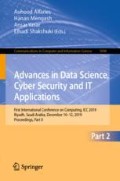Abstract
Reuse past experiences in solving new problems is common in the everyday lives, since it is well obvious and legitimate that similar problems have similar solutions and we are often confronted with a problem already met. The case-based reasoning (CBR) as a powerful design methodology of intelligent systems can be strengthened in the different stages of process by techniques for optimization. In a previous work [10], an approach guided by case-based reasoning based on retrieval by fuzzy decision tree has been proposed. In this paper, we propose a medical decision support system to assist physicians by adapting monitoring plans. The case-based reasoning process involves through several steps, we are interested in the adaptation phase which is to reuse totally or partially a solution of the selected case to solve the new problem. FUZZY DTA offers a medical decision making support system using a fuzzy reasoning for diabetes surveillance plans.
Access this chapter
Tax calculation will be finalised at checkout
Purchases are for personal use only
References
Smyth, B., Keane, M.T.: Retrieving adaptable cases. In: Wess, S., Althoff, K.D., Richter, M.M. (eds.) EWCBR 1993. LNCS, vol. 837, pp. 209–220. Springer, Heidelberg (1994). https://doi.org/10.1007/3-540-58330-0_88
Maher, M.L., de Silva Garza, A.G.: The adaptation of structural system designs using genetic algorithms. In: Proceedings of the International Conference on Information Technology in Civil and Structural Engineering Design (1996)
Dasarathy, B.V.: Nearest Neighbour (NN) Norms: NN Pattern Classification Techniques. IEE Computer Society Press, Washington, D.C. (1991)
Quinlan, J.R.: Induction of decision trees. Mach. Learn. 1, 81–106 (1986)
Pach, F.P., Abonyi, J.: Association rule and decision tree based methods for fuzzy rule base generation. Int. J. Comput. Electr. Autom. Control Inf. Eng. 2, 45–50 (2008)
Kalpana, M., Kumar, A.V.S.: Fuzzy expert system for diagnostics of diabetes using fuzzy determination mechanism. Int. J. Comput. Sci. Emerg. Technol. 2, 39–45 (2011)
Kalpana, M., Kumar, A.V.S.: Design and implementation of fuzzy expert system using fuzzy assessment methodology. Int. J. Sci. Appl. Inf. Technol. 1, 39–45 (2012)
Corchado, J.M., Aiken, J., Rees, N.: Artificial Intelligence Models for Oceanographic Forecasting. Plymouth Marine Laboratory, Plymouth (2001)
Qi, J., Hu, J., Peng, Y.: Incorporating adaptability-related knowledge into support vector machine for case-based design adaptation. Eng. Appl. Artif. Intell. 37, 170–180 (2015)
Benamina, M., Atmani, B., Benbelkacem, S.: Diabetes diagnosis by case-based reasoning and fuzzy logic. Int. J. Interact. Multimed. Artif. Intell. 5(3), 72–80 (2018)
Jain, V., Raheja, S.: Improving the prediction rate of diabetes using fuzzy expert system. Int. J. Inf. Technol. Comput. Sci. 10, 84–91 (2015)
Benbelkacem, S., Atmani, B., Benamina, M.: Planning based on classification by induction graph. In: International Conference on Data mining and Knowledge Management Process, Dubai (2013). ISBN 978-1-921987-15-1
Atmani, B., Benbelkacem, S., Benamina, M.: Planning by case-based reasoning based on fuzzy logic. In: International Conference on Computational Science and Engineering, Dubai, pp. 53–64 (2013)
Mokeddem, S., Atmani, B.: Assessment of clinical decision support systems for predicting coronary heart disease. In: Fuzzy Systems: Concepts, Methodologies, Tools, and Applications, vol. 184 (2017)
Arshadi, N., Badie, K.A.: Compositional approach to solution adaptation in case-based reasoning and its application to tutoring library. In: Proceedings of 8th German Workshop on Case-Based Reasoning, Lammerbuckel (2000)
Schmidt, R., Vorobieva, O.: Adaptation and medical case-based reasoning focusing on endocrine therapy support. In: Miksch, S., Hunter, J., Keravnou, E.T. (eds.) AIME 2005. LNCS (LNAI), vol. 3581, pp. 300–309. Springer, Heidelberg (2005). https://doi.org/10.1007/11527770_42
Jurisica, I., Mylopoulos, J., Glasgow, J., Shapiro, H., Casper, R.F.: Case-based reasoning in IVF: prediction and knowledge mining. Artif. Intell. Med. 12(1), 1–24 (1998)
Schmidt, R., Gierl, L.: Prognostic model for early warning of threatening influenza waves. In: Minor, M., Staab, S. (eds.) Proceedings of German Workshop on Experience Management, pp. 39–46. Köllen, Bonn (2002)
Guillaume, S., Charnomordic, B.: Learning interpretable fuzzy inference systems with FisPro. Inf. Sci. 181(20), 4409–4427 (2011)
Alonso, J.M., Magdalena, L.: Generating understandable and accurate fuzzy rule-based systems in a java environment. In: Fanelli, A.M., Pedrycz, W., Petrosino, A. (eds.) WILF 2011. LNCS (LNAI), vol. 6857, pp. 212–219. Springer, Heidelberg (2011). https://doi.org/10.1007/978-3-642-23713-3_27
Atmani, B., Beldjilali, B.: Knowledge discovery in database: induction graph and cellular automaton. Comput. Inform. 26(2), 171–197 (2012)
Barigou, F., Atmani, B., Beldjilali, B.: Using a cellular automaton to extract medical ınformation from clinical reports. J. Inf. Process. Syst. 8(1), 67–84 (2012)
Benamina, M., Atmani, B.: Définition d’un modèle booléen de raisonnement flou adapté à la planification. In: EGC, pp. 553–554 (2012)
https://archive.ics.uci.edu/ml/datasets/pima+indians+diabetes
Author information
Authors and Affiliations
Corresponding author
Editor information
Editors and Affiliations
Rights and permissions
Copyright information
© 2019 Springer Nature Switzerland AG
About this paper
Cite this paper
Benamina, M., Atmani, B., Benbelkacem, S., Mansoul, A. (2019). Fuzzy Adaptation of Surveillance Plans of Patients with Diabetes. In: Alfaries, A., Mengash, H., Yasar, A., Shakshuki, E. (eds) Advances in Data Science, Cyber Security and IT Applications. ICC 2019. Communications in Computer and Information Science, vol 1098. Springer, Cham. https://doi.org/10.1007/978-3-030-36368-0_11
Download citation
DOI: https://doi.org/10.1007/978-3-030-36368-0_11
Published:
Publisher Name: Springer, Cham
Print ISBN: 978-3-030-36367-3
Online ISBN: 978-3-030-36368-0
eBook Packages: Computer ScienceComputer Science (R0)

